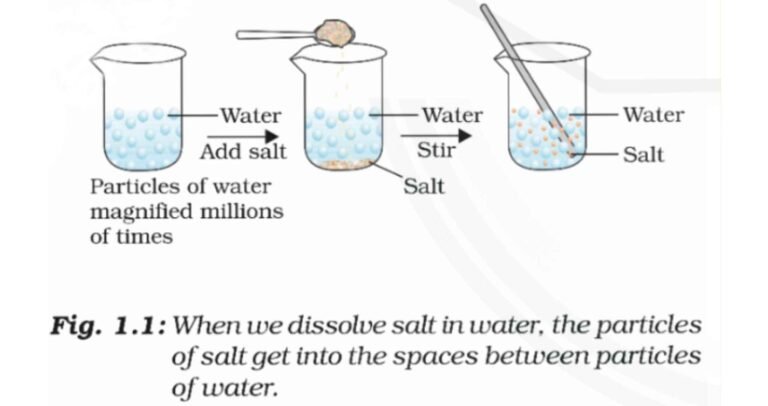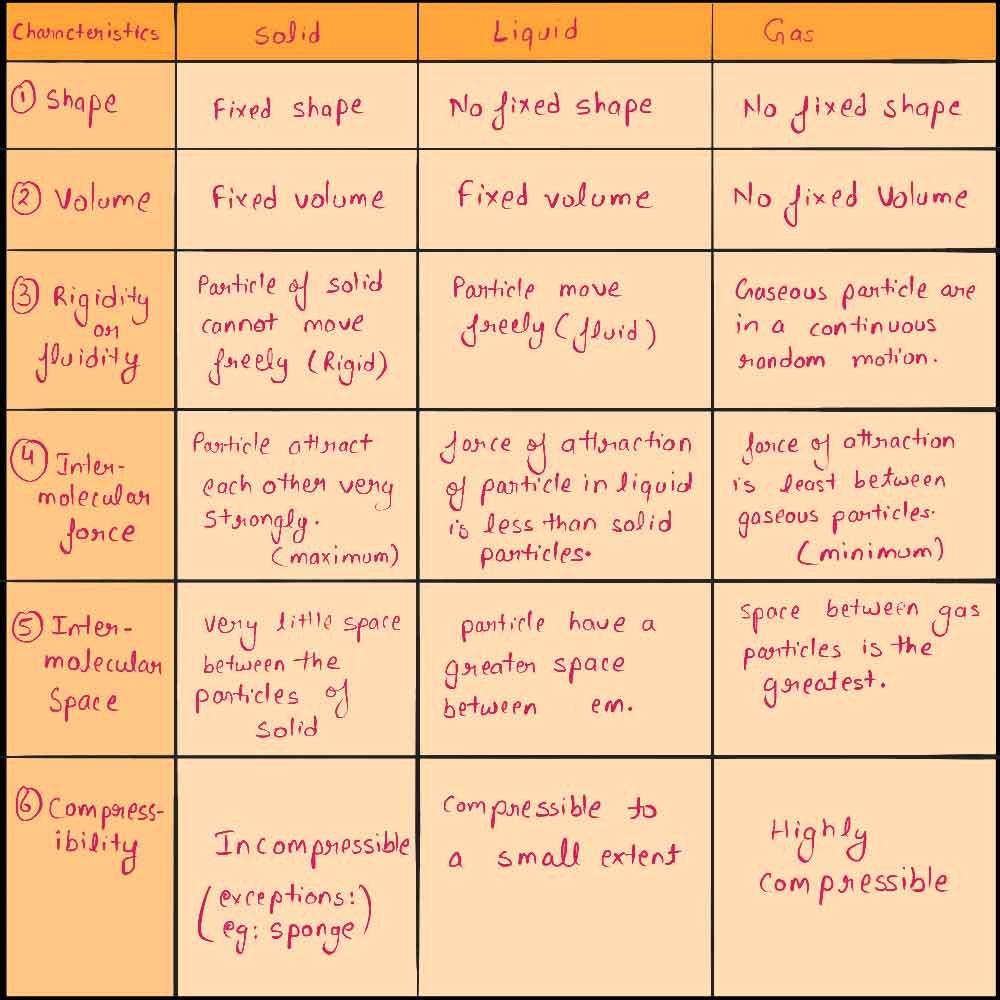Matter in Our Surroundings Class 9 Notes Science Chapter 1
Matter in Our Surroundings Class 9 Notes – Here I covered all important point or everything about this Chapter 1 Matter in Our Surrounding. These notes as per CBSE or NCERT based Which covers All Important Definition, All Activity Solutions, Topic wise Notes, Each section of NCERT will cover here, Intex Question and Answer, and not the least NCERT Exercise Solutions.
These notes help to those who are in class 9 and want to know about Chapter 1 Matter in Our Surrounding, These Notes help you to Understand and Memorize the concept easily. Here I covered complete Chapter 1 Matter in Our Surroundings class 9 notes.
Click Here : NCERT Solutions Class 9 Science Chapter 1 Matter in Our Surroundings.
Class 9 Science Notes Chapter 1 Matter in Our Surroundings
What is Matter?
Air, water, stones, sand, clouds, pencils, books – Everything is made up of matter. Matter is everything in this universe that occupies space and has mass.
Constituents of Matter
According to the early Indian philosophers, every living and non-living thing is made of five basic elements called the Panchtatava – Air, Water, Earth, Sky, and Fire. Therefore, matter is a composition of these five constituents.

Physical Nature of Matter
Is matter continuous or particulate?
Matter is particulate in nature. This means that matter consists of particles as you can see in the microscopic image of a cube above.
For Example, If we put a drop of red colour in water the colour of the water turns red. This happens because the particles of red colour mix with the particles of water.

What is the size of these particles?
- The size of the particles of matter is very small.
- They can be broken into further particles as well.
- For Example, On dilution of a colorful solution, as shown in the figure above, we can still see the color. This means there are millions of particles present in the color which just divide themselves on dilution.
Which of these is matter – happiness, air, sandwich, thoughts, juice, and eraser?
Air, sandwich, juice, and eraser as they have mass, they occupy space and can be broken into further particles.
Characteristics of Particles of Matter
Particles of matter have three characteristics:
1. Particles of matter have spaces between them.
2. Particles of matter are moving all the time.
3. Particles of matter attract each other.
Particles of Matter have spaces between them.
Have you ever wondered what causes salt to get dissolved in water?
Salt gets dissolved in water because their particles have spaces between them. The particles of the salt get in between the spaces between the particles of water and a mixture is formed.
We cannot see these particles through naked eyes.

Particles of Matter are continuously moving
Particles are continuously moving
{image)Particles are continuously moving
Particles of matter are in motion all the time. Hence, they possess kinetic energy.
Kinetic Energy – Energy due to motion.
The particles of a matter intermix on their own with other particles of a matter.
For Example, Salt in water, Various gases in the air, Ink in water.
Diffusion –
The process of mixing two different types of particles together is called diffusion. Diffusion becomes faster on heating.
{image} Before diffusion and After diffusion
The kinetic energy of particles also increases on heating.
Particles of Matter attract each other
The particles of matter are always held together because of a force of attraction between them.
The amount of this force between the particles varies in different forms of matter, as shown in the figure below:
Solids have the highest force of attraction. That is why we cannot move our hands through a solid object. The particles are so tightly bound.
Similarly, particles of gases have the least force of attraction in them. We can move our hands easily in the air, can’t we? This is because the particles of air are loosely bound.
We can arrange the force of attraction between different types of matter (solids, liquids, and gases) in increasing order as:
We can also move our hands through water or liquid matter but not as freely as we can in the air. This means that they are also loosely bound to some extent.
Gas < Liquid < Solids
States of Matter
Now we know that particles of matter have a force of attraction between them. Based on this criterion, we can say that matter is present in three different states:

The Solid State
Solids are the objects that have these three properties:
- They have a specific shape.
- They have distinct boundaries.
- They have a volume.
- There is less kinetic energy among the particles in solids.
- They are generally arranged in an order.
- Thus they possess a fixed shape.
- They cannot be compressed.
- The force of attraction is the maximum among the particles of solids.
- There is not much space between the particles. Therefore, they cannot be compressed.
Which of these are solids: Rubber band, Sponge, Salt?
All of them are solids. All of these follow the properties of solids. A rubber band and sponge change their shape only when we apply force on to them. It might appear to you as if salt is taking the shape of the container in which you put it but actually each of its grain has its own definite shape.
The Liquid State
Liquids have the following properties:
- Liquids have a fixed volume
- Liquids do not have a fixed shape.
- The force of attraction in liquid particles is less than solids. Therefore, there is a space between the particles of liquids and they can flow easily.
- They cannot be compressed. That is why they are also called fluids.
- Particles of liquids arrange each other is not fixed.
You might have seen that liquids take the shape of the container in which we put them. This is because the particles of liquids have a high kinetic energy, they always keep on moving.
Can other matter diffuse into liquids?
Yes, other matter can diffuse into liquids whether it is solids, liquids, or gases. This is so because there is a space between the particles of liquid so particles of other matter can slip into those spaces.
Diffusing solids into liquids: Mixing sugar in tea.
Diffusing liquids into liquids: Mixing ink in water.
Diffusing gases into liquids: The presence of oxygen and carbon dioxide in water.
The Gaseous State
Gases have the following properties:
- They do not have a fixed volume.
- They do not have a fixed shape.
- The particles of gases have the least or almost no force of attraction between them. Therefore, the particles have a large number of spaces between them and they can freely move in any direction.
- Also, they can be easily compressed and put into a small container, unlike solids and liquids.
Since there is a lot of space between the particles, different gases can diffuse into each other easily.
The kinetic energy between the particles is the maximum in the case of gases. Therefore, the particles move around freely at high speed and there is no fixed shape of gases.
Can Matter Change its State?
Water exists in three states:
- Ice – solid
- Water – liquid
- Water Vapor – Gas
This is an indication that matter can change its states.
Effect of Change of Temperature
What happens to matter when we heat it?
1. Solids:
- As we heat solids, the kinetic energy between the particles of solids increases which decreases the force of attraction between them.
- They start vibrating and changing their positions. Slowly, due to heat the particles become free and a solid converts into liquid.
Melting Point
The temperature at which solid melts to become a liquid at atmospheric pressure. For Example, the melting point of ice is 273.16 Kelvin.
Fusion
The process of melting of a solid into liquid is called Fusion.
In the melting process, once a solid reaches its melting point, its temperature does not increase further.
So where does all the heat go?
The heat present in the solid at time of melting is used by the particles to diminish the force of attraction between each other. The heat energy is therefore considered as hidden.
Latent Heat
The heat energy which is used to break the force of attraction between the particles of matter is known as latent heat. Since the heat is hidden therefore it is called as Latent Heat.
Latent Heat of Fusion
The amount of heat energy required to change 1 kg of a solid into liquid at atmospheric pressure at its melting point is known as the Latent Heat of Fusion.
Atmospheric Pressure
Pressure exerted by the weight of the atmosphere.
2. Liquids:
Just like in solids, the kinetic energy of particles of liquid increases, the force of attraction among them decreases and they start moving freely.
As we keep on supplying the heat, a point comes when the particles overcome the forces of attraction completely.
This is when a liquid starts changing into gas.
Boiling Point
The temperature at which a liquid starts boiling at the atmospheric pressure is known as its Boiling Point. For Example, The boiling point of water is 373 Kelvin.
Latent Heat of Vaporization
the amount of heat energy required to change 1 kg of a liquid into a gas at atmospheric pressure at its boiling point is known as Latent Heat of Vaporization.
What happens when we decrease the temperature?
1. Gases:
The kinetic energy between the particles decreases and they turn into a liquid state.
Condensation / Liquefaction
The process of converting a gas into a liquid by cooling down its temperature. For Example, The formation of clouds is due to condensation of water vapor from Earth.
2. Liquids:
The kinetic energy between the particles decreases and they turn into a solid state. For Example, The formation of ice.
Sublimation
Change of state of a gas directly into solid and vice-versa is known as sublimation. For Example, Camphor is a solid that directly evaporates into the air without changing to a liquid state.
Therefore, by increasing or decreasing the temperature we can change the states of matter into one another. Here is a diagram that sums this up.
Effect of change of Pressure
By applying pressure, we can bring the particles of matter close to each other thereby, increasing the force of attraction among the particles.
When we compress and decrease the temperature of a gas, the gas changes into a liquid.
Dry Ice
Carbon dioxide in solid form is known as Dry Ice. It can directly turn into gas by decreasing the pressure to 1 atmosphere.
Particles of matter are never at rest.
Particles of matter possess different amounts of kinetic energy.
The particles of liquids have more kinetic energy. Therefore, they are able to overcome the forces of attraction and convert into vapor without any external forces.
Evaporation
The phenomenon of change of a liquid into vapors at any given temperature below its boiling point is called Evaporation. Evaporation is different than boiling, as shown in the figure below.
How evaporation causes cooling?
The process of evaporation uses the energy of the liquid particles. Therefore, the particles absorb energy from the surroundings in order to compensate the energy that is being lost in the process of evaporation. This results in cooling of the surrounding area.
For Example:
- Our palms feel cool when we put some acetone (nail paint remover) on it
- People sprinkle water on their roofs or ground on sunny days to cool the area
- We are able to sip hot tea faster in a saucer than in a cup
Why people wear cotton clothes in summer?
We perspire more in summer. As the sweat evaporates it takes energy from our body surface and keeps our body cool. Cotton can absorb the sweat easily and exposes it to the atmosphere causing evaporation to take place easily. This, in turn, keeps us cool in summer days.
Why water droplets appear on the surroundings of a glass with ice-cold water?
There are water vapours present in the air. When they come in contact with the walls of the glass that has ice-cold water in it they condense. As a result, their state changes from gaseous state to liquid state thus forming tiny water droplets on the walls of the glass.
The Five States of Matter
By far we have discussed the three states of matter – Solid, Liquid, Gas.
But, scientists have discovered that there are two more states of matter –
- Plasma
- Bose-Einstein Condensate
{image}The Five States of Matter
Plasma
It is a state of matter in which the particles are super excited and super energetic. They are in the form of ionized gases.
For Example – Fluorescent tubes and neon light bulbs consist of plasma
The neon bulbs contain neon gas and there is another gas such as helium in the fluorescent tube. As electricity is passed in the tube or the bulb, these gases get ionized and this creates the plasma inside them that glows.
In fact, the Sun and the stars glow because plasma is present in them. Here are some examples of Plasma.
Bose-Einstein Condensate (BEC)
It is the fifth state of matter discovered by Albert Einstein on the basis of the studies conducted by an Indian scientist Satyendra Nath Bose.
BEC is formed by condensing gases of extremely low densities to much lower temperatures.
Important Measurement Units
SI Unit of Mass Kg (Kilogram)
SI unit of Volume m3 (cubic meters)
Common unit of Volume L (Liters)
SI unit of temperature Kelvin
0 degree Celsius = 273.16 K or 273 K (approximately)
Kelvin = Celsius + 273
SI unit of Pressure Pa (Pascal)
For measuring pressure exerted by Gas Atmosphere (atm)
1 atm = 1.01 X 105 Pa
Normal Atmospheric Pressure = 1 atm (at sea level)
NCERT Notes for Class 9 Science
- Chapter 1 Matter in Our Surroundings Class 9 Notes
- Chapter 2 Is Matter Around Us Pure Class 9 Notes
- Chapter 3 Atoms and Molecules Class 9 Notes
- Chapter 4 Structure of the Atom Class 9 Notes
- Chapter 5 The Fundamental Unit of Life Class 9 Notes
- Chapter 6 Tissues Class 9 Notes
- Chapter 7 Diversity in Living Organisms Class 9 Notes
- Chapter 8 Motion Class 9 Notes
- Chapter 9 Force and Laws of Motion Class 9 Notes
- Chapter 10 Gravitation Class 9 Notes
- Chapter 11 Work, Power And Energy Class 9 Notes
- Chapter 12 Sound Class 9 Notes
- Chapter 13 Why Do we Fall ill Class 9 Notes
- Chapter 14 Natural Resources Class 9 Notes
- Chapter 15 Improvement in Food Resources Class 9 Notes
